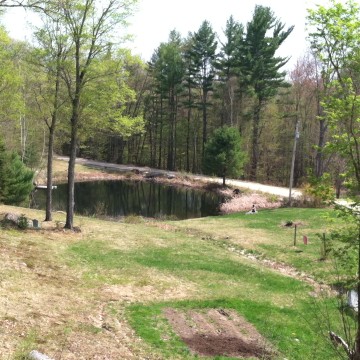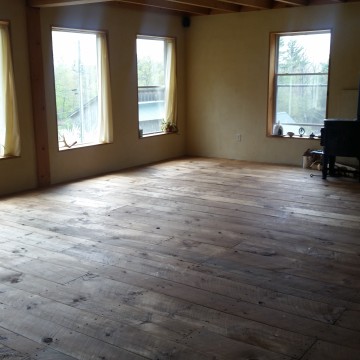Last weekend I had the rare opportunity to take a mini-vacation over a three-day weekend to a beautiful organic farm in New Hampshire, Bethel Farm. The occasion was a short yoga retreat being run by two of my yoga teachers here in NYC who are trained in the Jivamukti school (the owner of the farm was also a yogi, and practiced and chanted with us throughout the weekend). It was a blissful, restorative time for me–one of the only times, actually, I could genuinely use those words.
The trip took just about 5 hours by car (minus bathroom breaks and other distractions–the five of us city girls in the car were bewildered by nature! trees! sunshine!), and so we were all pretty happy when we rolled up to the tucked-away oasis of a farm. The prospects for the weekend were overwhelmingly exciting, but the first thing I noticed wasn’t the pond, compost area, greenhouse, or, most importantly, the Yoga Castle, where we slept, drank tea, watched the stars, and oh, also did some pretty amazing yoga; rather, it was the complete silence of the air–and my head. There was a chirp in the far distance, the rustle of some tall grasses, and absolutely nothing else. It took me a few minutes to realize what felt so different in this place, and when I did I took a deep breath hoping that it would fill my entire body and wash it clean of all the noisy sludge that had been building up.
Most of the time, especially those of us who live in cities, we are highly cognizant of the noises that surround us. Barking dogs, crying babies, ringing cell phones, ambulances, traffic jams, garbage trucks. We want to turn them off so badly, to escape to the cliche world of our “quiet place.” But how often does one actually notice quiet? And what does quiet do to brains like ours, which are constantly filled with chatter–even the kind that’s not audible?
Besides the strength and flexibility I discovered within myself during the retreat, learning how to find stillness was the most powerful thing I took away from it. Normally, I’m a pretty antsy person: I’m always on the go physically and mentally, worrying about something or someone (usually out of my control), making schedules and lists and crossing things off of them. But when I found myself in a place where there was no outside noise–mornings, until our first class was over at around 10:30, were observed in silence, so even during our jump-backs into chutaranga we could hear birds warbling in the trees; afternoons, we went into the woods on a silent, walking meditation; evenings, I drifted off to sleep feeling a little sore but nimble, not to the soundtrack of my neighbor’s air conditioning unit but a choir of crickets–I found that my active mind could be still, too. For the first time, meditation worked. And I understood what it means to think of our minds as a pond (we had a real-life example outside the window, which helped a lot in the visualization process): there will always be waves, or even small ripples, which situations outside of us arise and shake us up. But when we can restore the surface to stillness, we can understand what caused the disruptions, by looking at the glassy surface and deep down to the bottom of the pond, and see what truths lie there.
Gaining this enlightenment was a double-edged sword, for it made returning to Manhattan even more difficult. The endless stream of unanswered emails on my home and work computers, the fight through tiny grocery store aisles to hunt for fresh produce I couldn’t really afford (no greenhouse next door!), the desire to catch up on all I’d missed, and tell people how my trip was–all this would break the stillness and blast noise into my mind at full volume.
Instead of letting this get to me, though, I decided to actively seek silence more often, even if only the metaphorical kind. Being silent and still in real life doesn’t mean not speaking, or not engaging in society: it just means being aware and mindful, and able to know when it’s important to listen and when it’s not. Carrying the silence of the farm with me, I was able to tackle the challenges of the day(s) ahead with a clear mind. The answers to the 1001 problems I felt I had to solve in a nanosecond were all just there, under the surface, and as long as remembered to look, and not get distracted by the noise around me, I could find them easily.
What do you do to escape the noises around us and in our heads? Share your tips, including on meditation!
Related: Inspired Living – On Living with Chronic Anxiety
Why Am I Angry? How to Deal with Irritability
How to Take a Technology Break
Get more like this–sign up for our newsletter for exclusive inspirational content!
__
Photo: Jennifer Kurdyla






